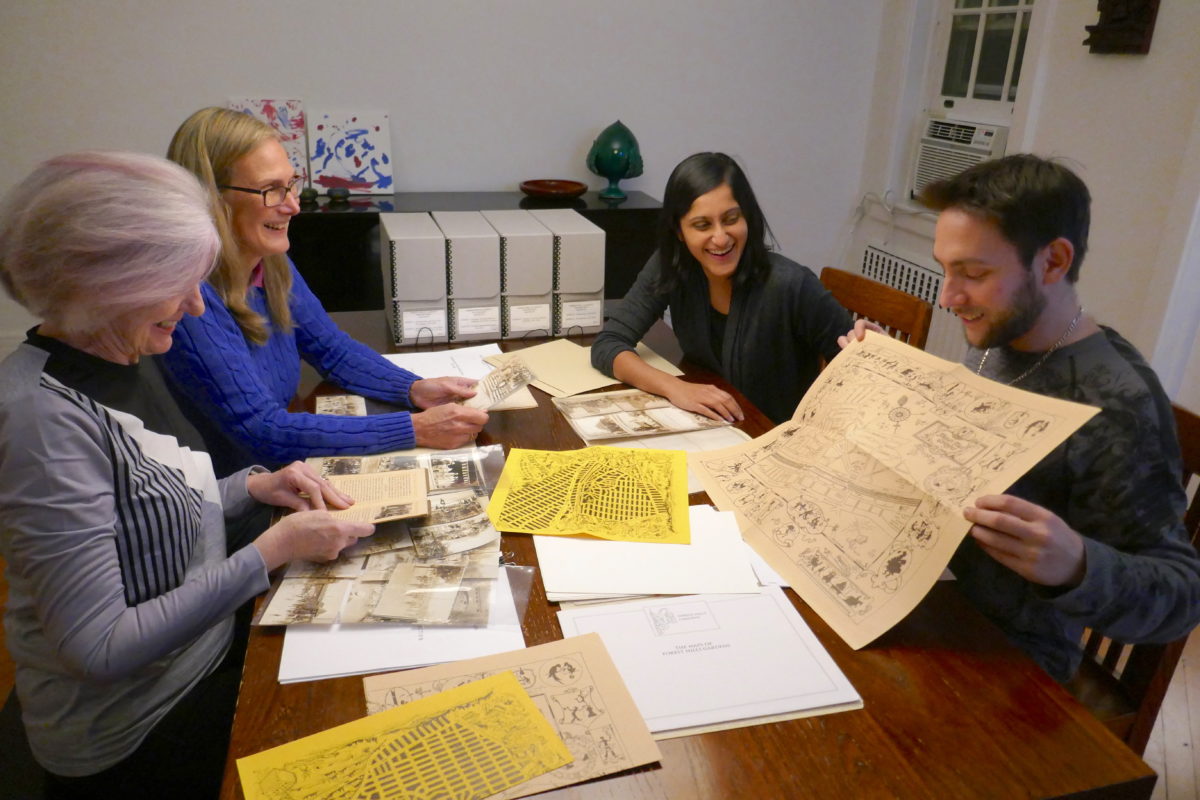Forest Hills Gardens Foundation updates archive, engages public
Rediscovering and preserving Forest Hills Gardens history
By Michael Perlman
mperlman@queensledger.com
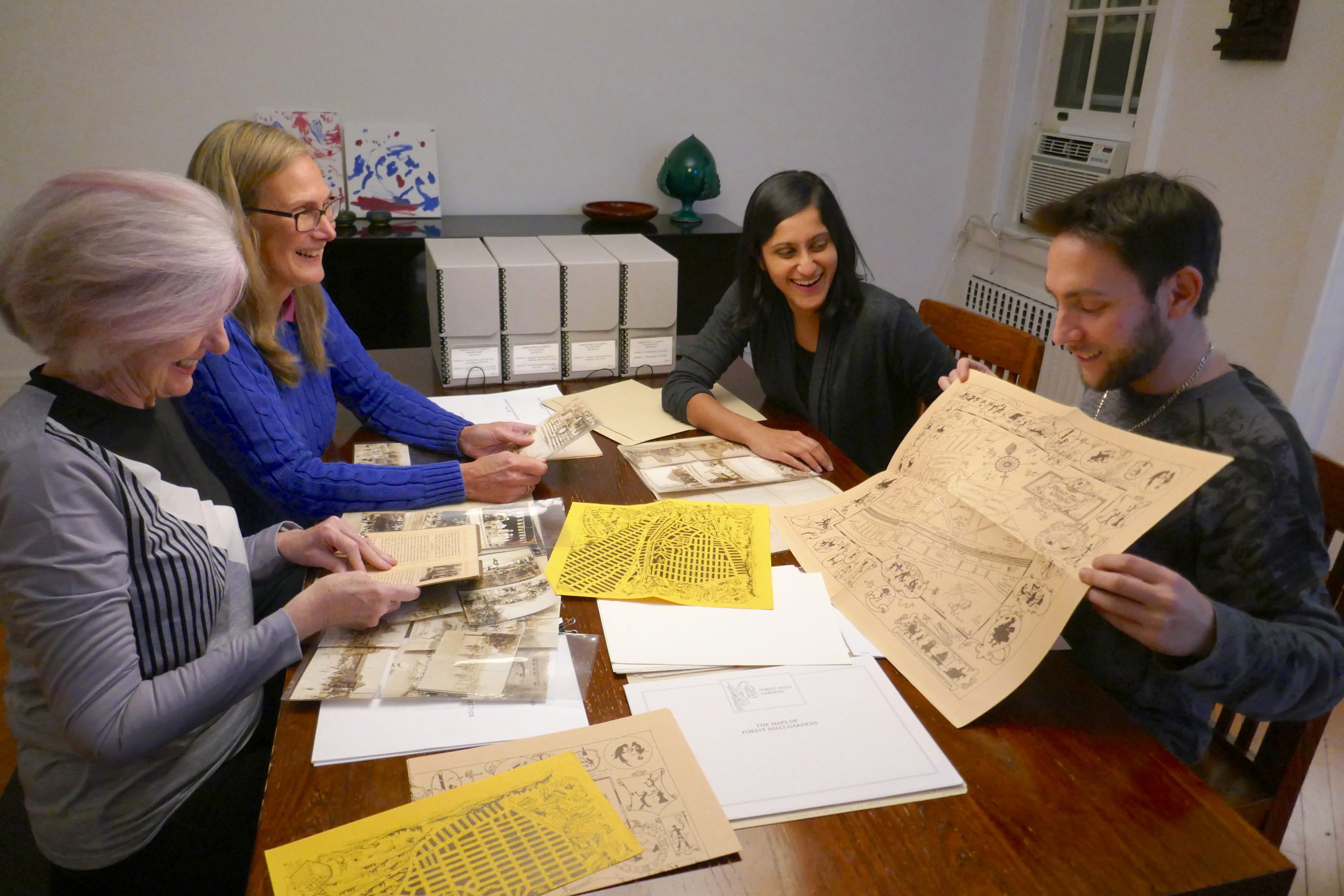
Archives Committee of FHG Foundation at work.
The Forest Hills Gardens Foundation’s board and Archives Committee is on a mission, preserving a photo, illustrated map and a publication at a time.
Last week, they reviewed the archives, and brainstormed how to take it a step further by sharing never before seen memorabilia with local to worldwide residents and researchers.
The locations featured in most photos are easily identifiable, but as for others, the Foundation and residents may feel like team players and can say, “There’s a mystery on our hands.”
Many photos featuring early Gardens residents also remain to be identified.
Founded in 1909, Forest Hills Gardens, designed by principal architect Grosvenor Atterbury and landscape architect Frederick Law Olmsted, Jr., is a quintessential example of an earliest planned garden community nationally.
This model residential development, complete with Tudor and Arts & Crafts-style mansions and rowhouses, few apartment buildings, winding streets, lush parks and monumental trees, was inspired by Sir Ebenezer Howard’s Garden City Movement.
Today, clubs including the Men’s Club of Forest Hills, Women’s Club of Forest Hills and West Side Tennis Club remain in existence, which are testaments to neighborliness and community spirit for generations.
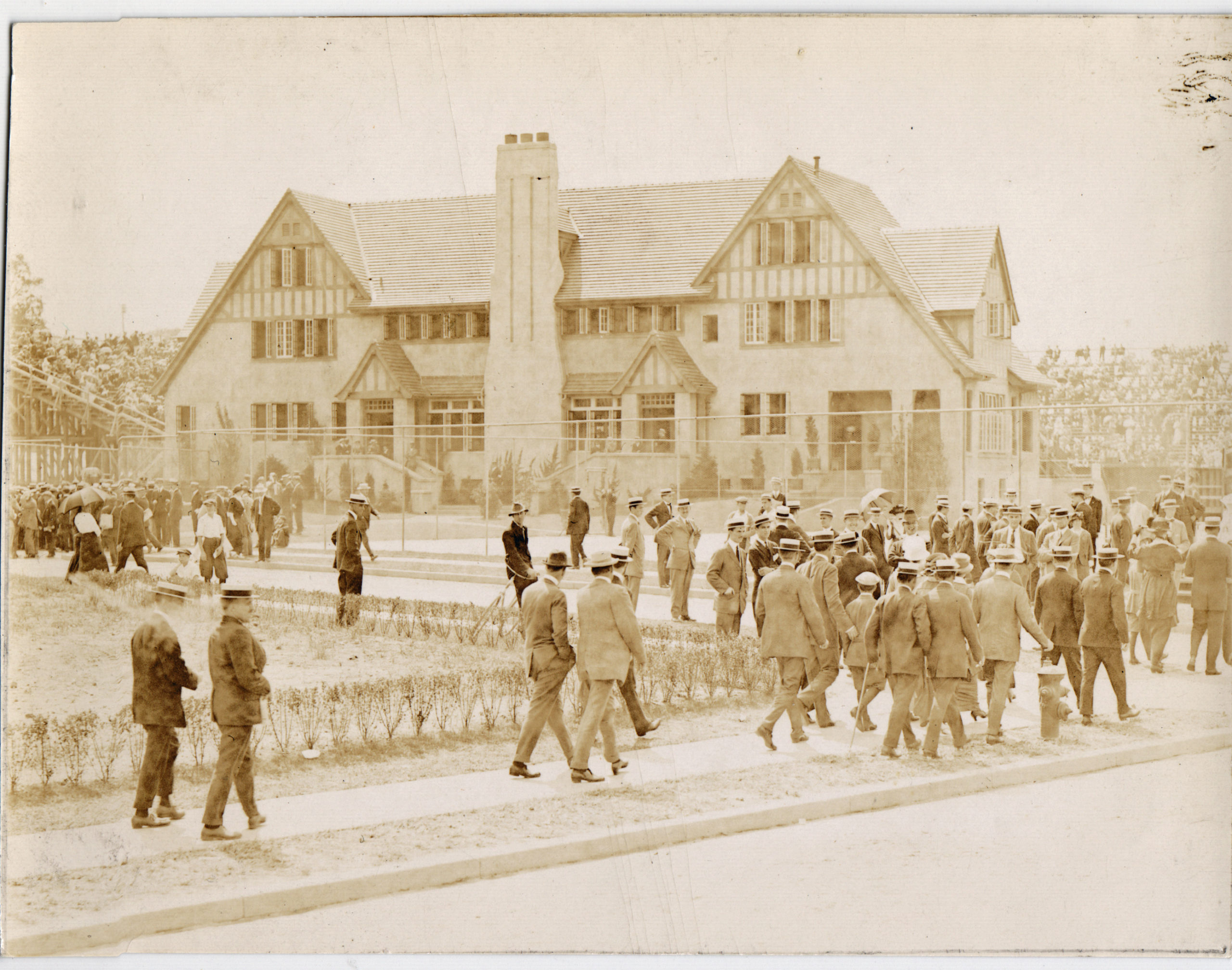
Clubhouse of West Side Tennis Club.
The Forest Hills Gardens Foundation’s history can be traced to 1909 as an advocacy group, formerly known as the Forest Hills Gardens Taxpayers Association (FHGTA), with a mission statement that reads: “The purpose of the Association shall be the promote the common welfare of all persons residing within the territory of Forest Hills or Forest Hills Gardens.”
“They successfully advocated with government and service providers to help obtain a local fire company, increased rail service, a post office, schools, a playground and much more,” said Foundation President Bruce Eaton, a 23-plus-year Gardens resident who feels that he enjoyed every minute of it.
“The Gardens is an important community from a historical perspective, but also to those of us who live here. It is a physical manifestation of how good community planning can enhance our quality of life,” he continued.
As for the Foundation, he explained, “Residents crave to know our history, so it falls on us to help preserve it.”
Although the Foundation originated as the FHGTA, it morphed into the Community Council circa 1919.
“When the Sage Foundation Homes Company pulled out of the Gardens in 1922, the community formed the Forest Hills Gardens Corporation to take over the community’s maintenance. Many of the people who helped create the FHGC and who became leaders within the FHGC were from the Community Council,” Eaton continued.
“There has always been synergy.”
When residents and visitors picked up a copy of “Forest Hills Inn,” an early 20th century illustrated pamphlet by philanthropic organization Russell Sage Foundation’s subsidiary, Sage Foundation Homes Company, they learned about the Gardens’ benefits of location, education and business, as evident by the planning of parks and open spaces alongside homes embodying architectural treatment.
This primary source exists within the archives. The archive also enables its audience to realize the potential for restoring neglected sites such as the historic Flower Shop and trying to solve the mysterious disappearance of relics such as original signage from a series in Station Square, which is supposedly safeguarded by restrictive covenants.
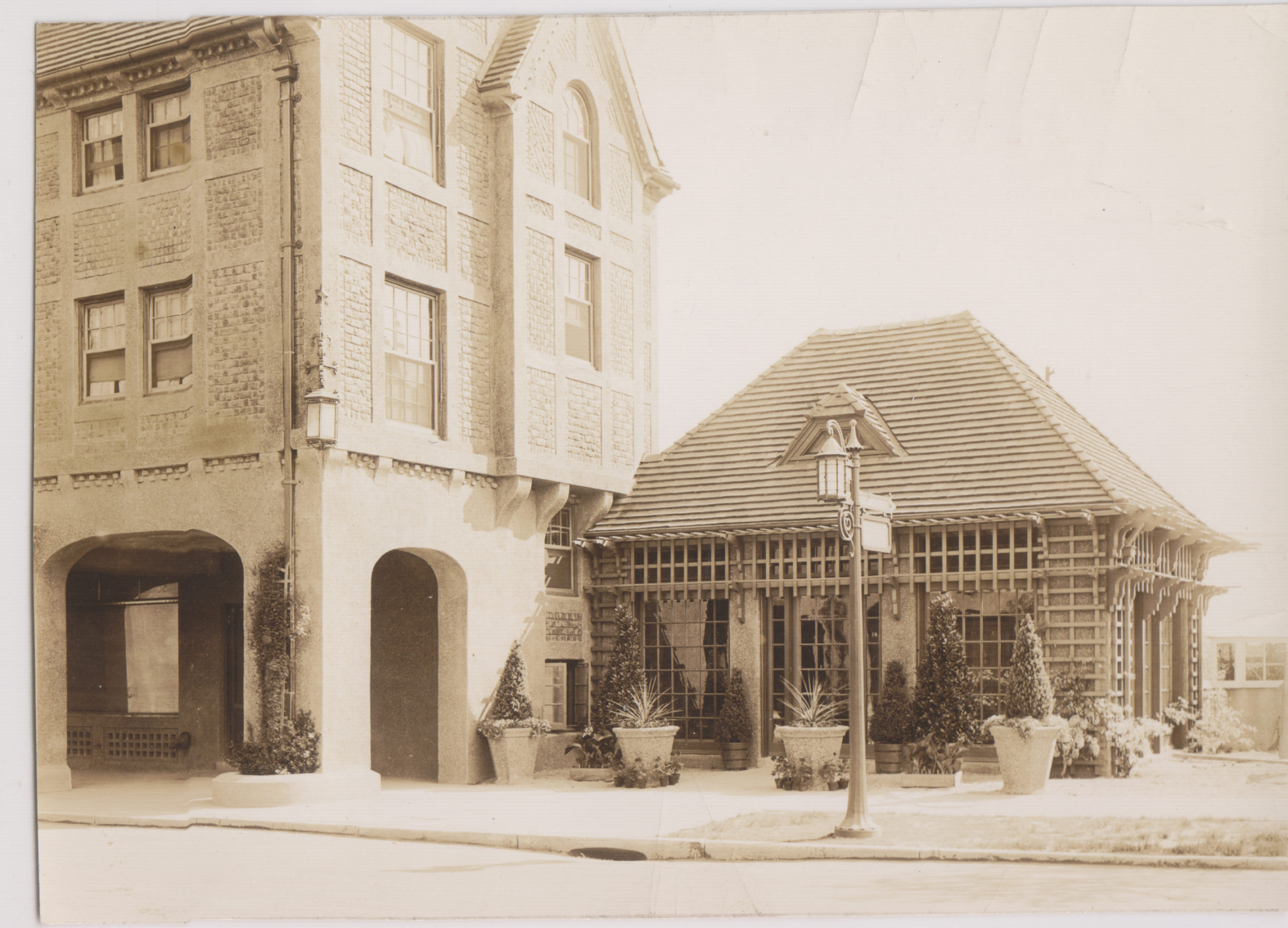
Forest Hills Flower Shop circa teens, but now abandoned.
The Forest Hills Gardens Foundation’s archive features historic events such as annual Fourth of July celebrations in Station Square, which includes Col. Theodore Roosevelt’s “100 Percent American” speech on July 4, 1917 at Forest Hills Station, as well as festive gatherings on Flagpole Green.
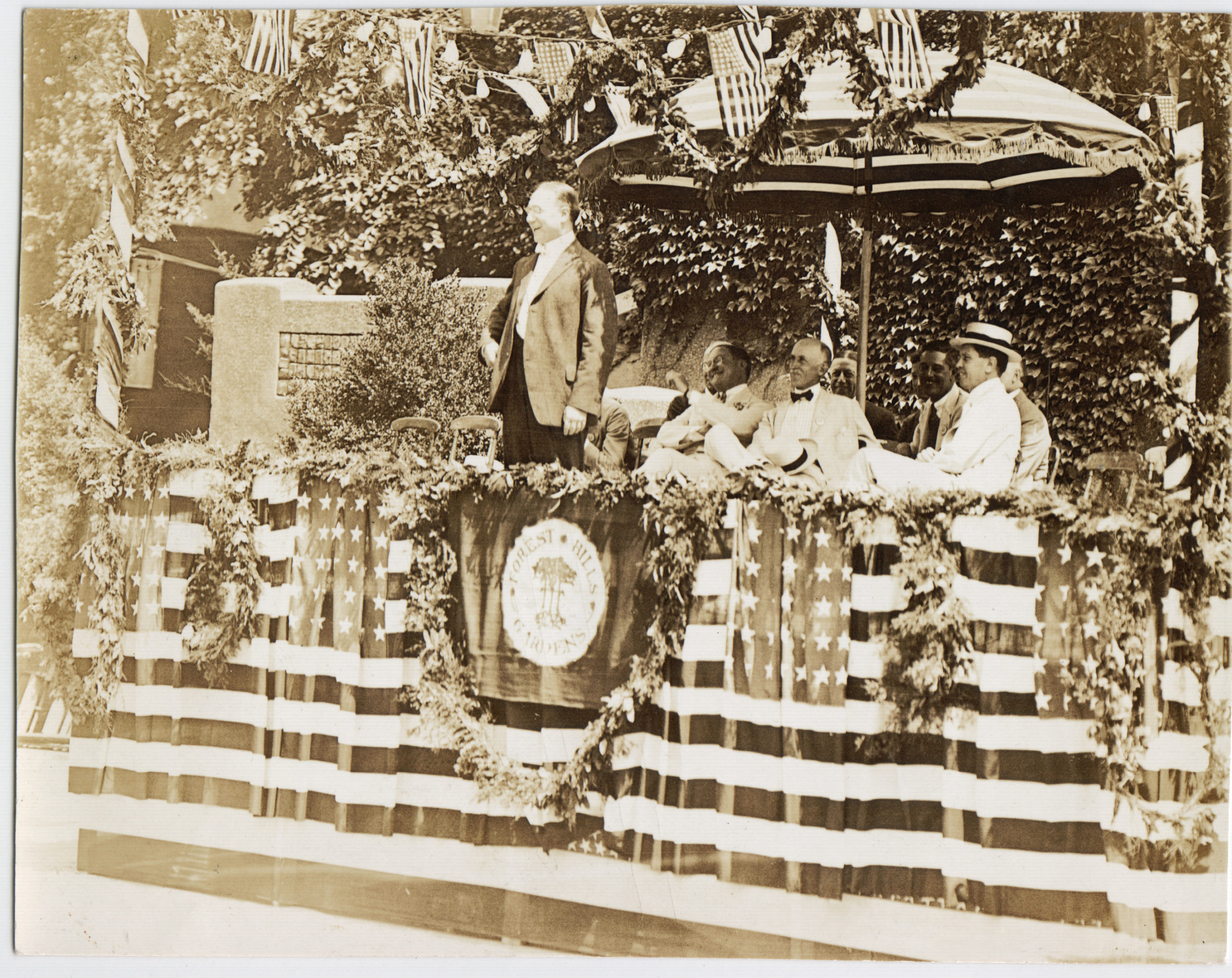
Col. Roosevelt delivers his 100 Percent American speech, July 4, 1917.
Eaton began serving as Treasurer in 2011 after longtime resident Paul Stanley died.
The much-admired William E. Coleman served as President since the 1990s, and then in 2018, Eaton acquired his role, representing a younger generation of Foundation leadership.
That is also when the organization was renamed from the Forest Hills Gardens Taxpayers Association.
Major committees include Finance, Nominating, Archives and Website & Marketing.
“We have 10 board members and are looking to expand,” Eaton said.
The Forest Hills Gardens Foundation’s board and Archives Committee consists of diverse members who have a significant interest in history and participation in community affairs.
Forest Hills Gardens resident Bea Hunt, who co-chairs the West Side Tennis Club’s Tennis History & Archives Council, is also grateful to serve on the Board and Archives Committee of the Foundation.
“We have a unique opportunity to expand the Foundation’s physical and electronic archives, in order to document and preserve our great heritage for residents and researchers worldwide,” she said.
“I am delighted to serve on the board of the Foundation, since it fills a large vacuum in the preservation of our local history,” said resident Ann Chamberlain, who is also active on the board of the Forest Hills Women’s Club and has served on the Forest Hills Gardens Beautification Committee.
She explained, “The Forest Hills Gardens Corporation’s mission is to maintain, and where needed, repair the physical plant that is the Gardens, whereas we strive to record the Gardens’ evolution throughout its over 100-year existence.”
One may wonder about an estimate of historic images and documents that exist within the archive.
“We are planning on doing a drive to gather more photos and documents on our website, but there are 829 historic images and 340 historic documents, dating from 1910 to 1935 or so. We have over 100 vintage home photos that current owners seem to enjoy,” Eaton said.
Some of his standout images are the early construction of Station Square and early community events such as Children’s Day.
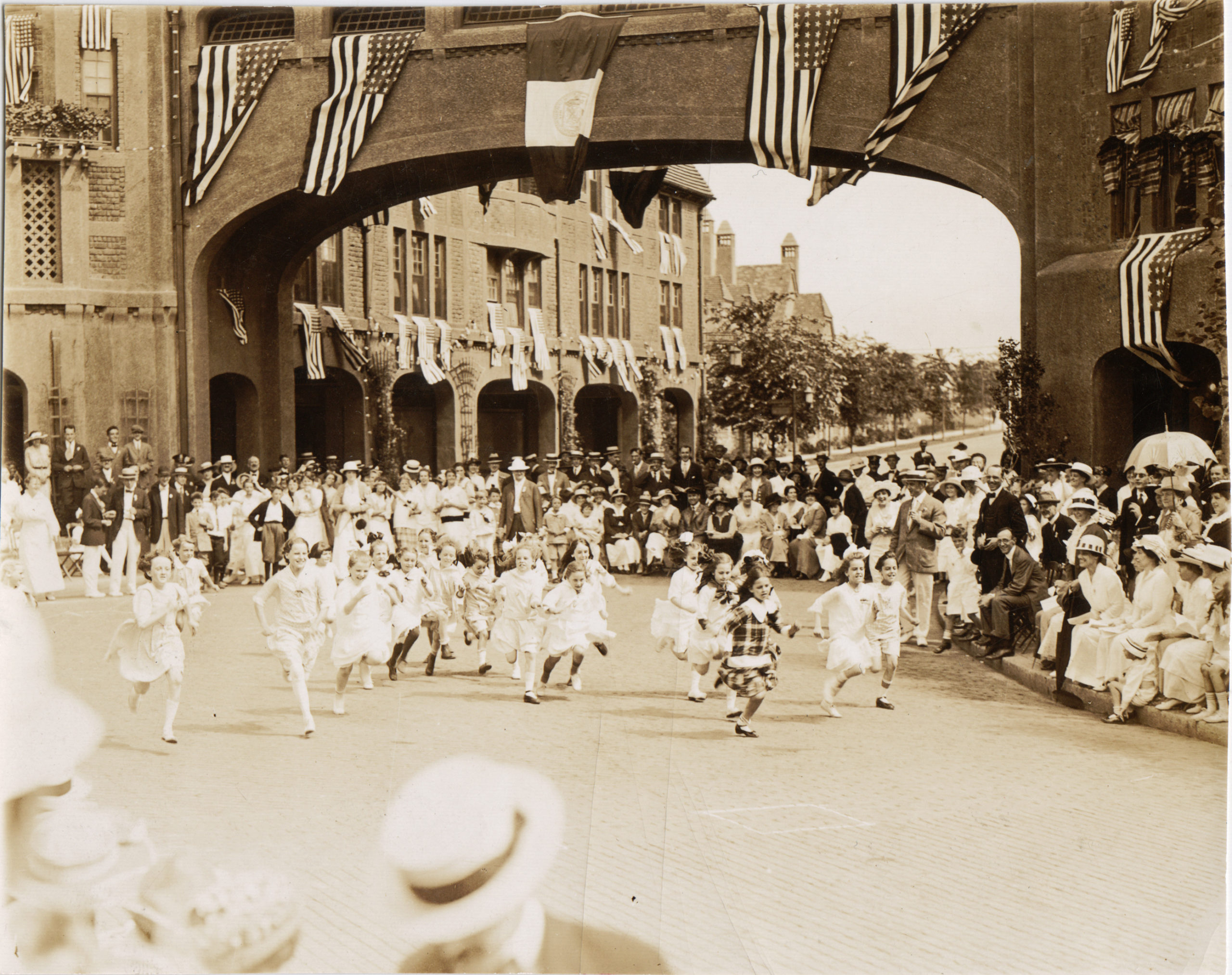
Childrens games at annual 4th of July festivities circa teens.
“Perhaps my favorite depicts horses drinking from the horse trough (now benches) that was in the middle of Station Square,” he added.
Eaton is also very much intrigued by Forest Hills Gardens Bulletins by the Sage Foundation Homes Company from 1915 to 1925.
“There are so many things that are still topical today, such as mosquito control and the Spanish Flu of 1918, and many others that truly reflect the time; such as WWI’s impact and the process of building a community,” Eaton said.
In 2017, www.foresthillsgardensfoundation.org was launched, and it has become a searchable resource.
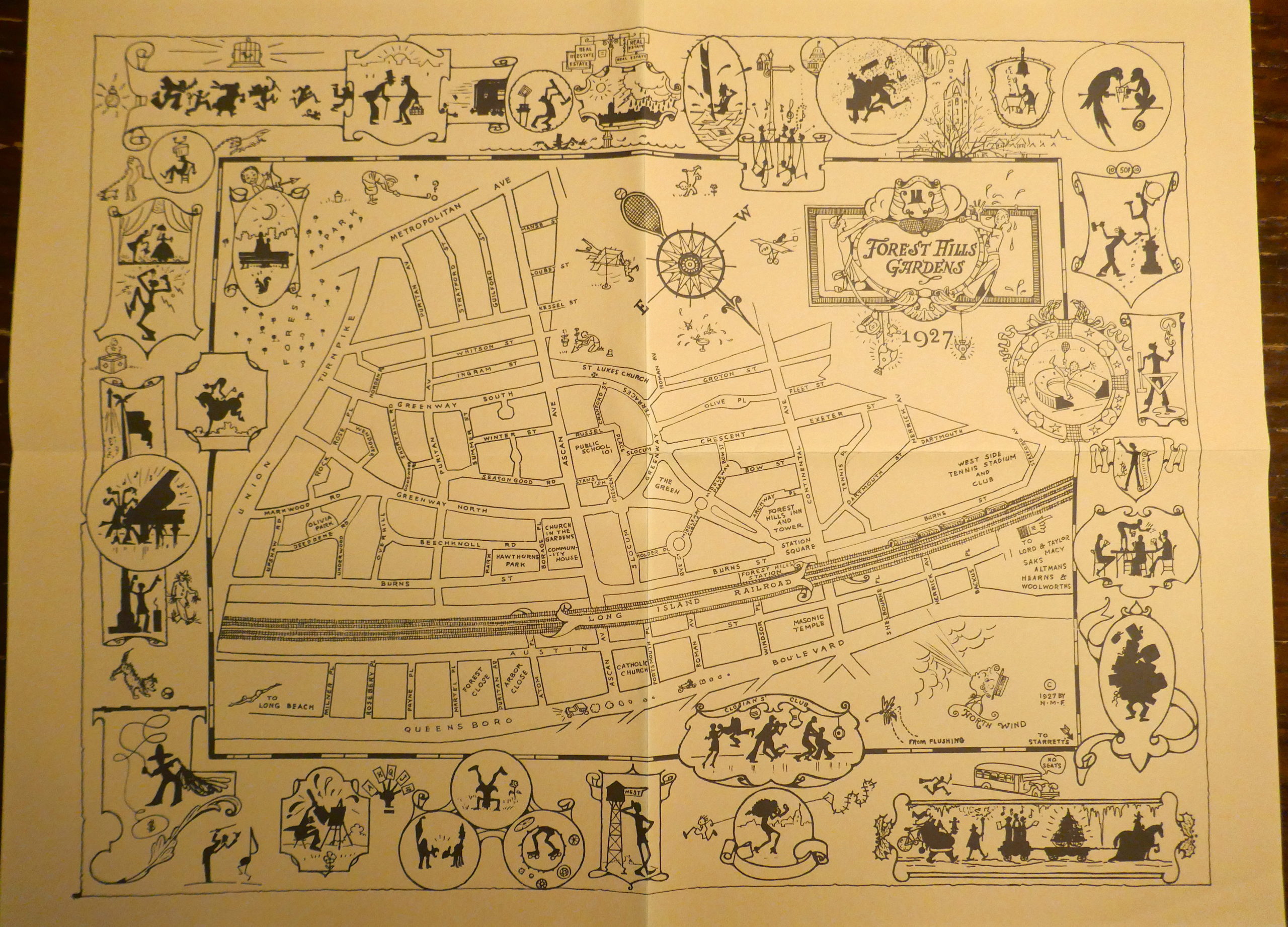
Highly illustrated Forest Hills Gardens map, 1927.
Eaton said, “In the upcoming year, we intend to scan the Gardens Bulletins in a more interactive format. They are online now, but you cannot perform internal searches. A portion of the photographic images are downloadable, but we intend to make them all downloadable at some point.”
Eaton believes that there is nearly not as much awareness of the Foundation’s pursuits as there could be.
“Many residents would enjoy perusing the content on our website if they know about it. I also feel they would be surprised at our achievements spanning a 113-year history,” he explained.
To organize and catalog an extensive collection based on professional standards, Certified Archivist Lois Kauffman was appointed, and in January 2022, archival records were organized in acid-free folders and five archival document boxes.
Rusty metal was removed and deteriorating documents were copied onto acid-free paper. Then a finding aid was produced to inventory and describe the collection.
The collection consists of six series: Incorporation, bylaws, tax exemption; Board of Directors; Projects, activities, history, publicity; lectures and special events; publications; photographs.
A decision was made to store these materials in an environmentally-controlled storage facility.
Eaton explained the next steps. “Now that we have a real structure, we will conduct outreach to local residents to gather more materials that we know many residents have. We will add to our collection and make them available digitally. The Seeler family, longtime residents, agreed to donate bound copies of Forest Hills Gardens Bulletins, which we will make scannable online. At some point, we may request materials that the Sage Foundation donated to Cornell University and are stored there.”
When the Foundation reoriented its focus on education and preserving history, at least one major event takes place annually.
Eaton said, “This year, we held a presentation honoring the 200th anniversary of Frederick Law Olmsted’s birthdate, with Olmsted biographer and Gardens resident Justin Martin speaking. It also featured a video we produced of the Olmsted family’s impact on the Gardens.”
In recent years, also of great public interest, was a film and lecture about the Olmsteds and presentations by guest experts on Grosvenor Atterbury and the influences that shaped the Gardens.
Scholarly articles have also been published locally.
According to Eaton, the board has some very ambitious thoughts on what the Foundation can become. “We have been debating a drive to create a physical presence in the Gardens where residents can come browse our materials and website in a gallery-like setting, but that would be a long way ahead.”
Although restoring historic properties falls outside their scope, the board and Archive Committee may be able to assist with research requests to help accomplish that.
To submit vintage photos or reproductions, email foresthillsgardensfoundation@gmail.com.



